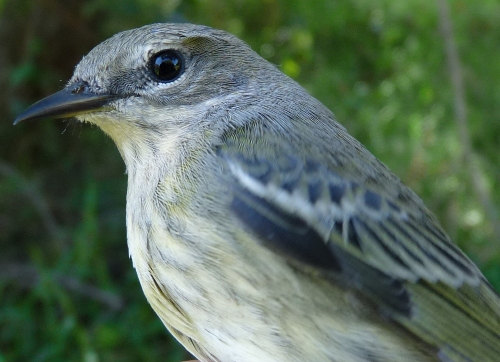|
McGILL BIRD OBSERVATORY |
||||||||||||||||||||||||||||||||||||||||||||||||||||||||||||||||||||||||
Welcome
to the McGill Bird Observatory weekly report.
Click here for a complete listing of our archives.
Banders-in-charge: Simon Duval, Marcel Gahbauer, Gay Gruner Notes: At times this week it almost seemed like the birds had read last week's report and were determined to show us what a REALLY slow fall week is like. Only on Friday did we finally band more than 15 birds in a day, and even then the total of 25 was rather slow for this time of year. For comparison, last year during this week we banded 343 birds, and in the previous three years our range had been from 162 to 279. Diversity was also quite low, with daily estimated totals often in the 35 to 40 species range, and the weekly total of 75 the fewest we've ever had at this time of year. Why such a slow week? It's hard to say, as various factors could be at play. As noted last week, a poor breeding season in much of the boreal forest could be at least partly to blame. However, it was also a rather warm week (temperatures a few degrees above the seasonal norm) with remarkably consistent conditions, so the lack of distinct weather fronts might have held back some birds longer than usual. Again, all we can do is wait and watch how the rest of the season unfolds. Despite how quiet the week was compared to our expectations, we added some species to our seasonal and yearly totals as usual. A Black-billed Cuckoo detected while opening nets one morning was our first observed at MBO this year; other species seen for the first time this fall were Spotted Sandpiper, Ruby-crowned Kinglet, Western Palm Warbler, and Cape May Warbler. The Palm Warbler was our first to be banded this year, as was the Philadelphia Vireo featured lower down on this page. We also had our first Rose-breasted Grosbeak return of the year (i.e. a previously banded bird not recaptured for at least 3 months), a male we banded two years ago.
In the first two weeks of August we banded 20 White-throated Sparrows, almost all juveniles that must have come from nests rather nearby. Since then though, we've banded relatively few additional ones, so the sudden appearance of the species at the top of our list of species banded this week is a sure sign that the migrants from further north have started to arrive ... and we expect them to remain among the most dominant species for the next few weeks. Magnolia Warbler and Song Sparrow remained near the top of the list this week; of note, we banded 109 Magnolia Warblers during this week last year, so that is a significant factor explaining this year's lower total. American Redstart dropped to fourth place this week, marking the sixth week in a row that it has ranked at least that high, an impressive streak of consistency. They dropped off noticeably though as week 6 progressed, so it's possible they will fall off the list next week as more northern species arrive in (hopefully) larger numbers. The "blue birds" (Indigo Bunting, Black-throated Blue Warbler, and Blue Jay) all had a good showing this week. Although remaining numerous, Black-capped Chickadees continued to largely elude the nets this week.
The Canada Goose flocks continue to grow slowly, putting them on top of our list of most observed species for a second week in a row. The rest of the top seven is also awfully similar to last week, with only Common Grackle and American Goldfinch switching between fifth and sixth place, and Black-capped Chickadee being pushed down by increases in the number of American Crows and Cedar Waxwings. The bottom three spots are occupied by American Robin, White-throated Sparrow, and Song Sparrow, the first two of which are likely to increase substantially in prominence over the coming weeks. Extra thanks this week to Ryan Young for organizing the annual Ecology Day in Ste-Anne-de-Bellevue and offering MBO a prominent booth there, as well as to Tiffany Gilchrist and Marcel Gahbauer for staffing the booth. If you're reading this as a result of having stopped by to chat, we look forward to having you out at MBO as volunteers!
|







